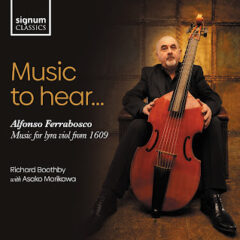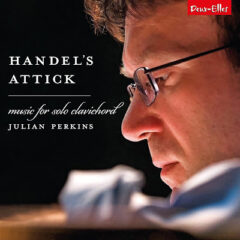
Richard Boothby, Viola da Gamba professor, Royal College of Music, London
Part 1
Music of Engaging Variety and Imagination
Review by Robert Hugill
 MUSIC TO HEAR…
MUSIC TO HEAR…
Alfonso Ferrabosco: Music for the Lyra Viol
Richard Boothby, Asako Morikawa
Signum Classics
The lyra viol is a type of small bass viol that was popular in England in the 17th century and for which a specific repertoire was created. Viol player Richard Boothby has already recorded the complete lyra viol music of William Lawes and here, on a new Signum Classics disc Music to hear…, Boothby turns his attention to pieces from Alonso Ferrabosco’s Lessons for 1, 2 and 3 viols. The majority of the works on the disc are for solo viol, but Boothby is joined by Asako Morikawa for some.
Despite his exotic name, Alfonso Ferrabosco (1575-1628) was English. His father, Alfonso Ferrabosco, the Elder was an Italian composer, born in Bologna, who ended up in England working for Queen Elizabeth I. Marriage to an English woman followed, but then he returned to Italy leaving his son as security with a flute player who played for the Queen. The elder Alfonso never returned to England, but his son flourished under both Queen Elizabeth and King James I. An association with the playwright Ben Johnson began in 1605 when he wrote the music for the Masque of Blackness, designed by Inigo Jones, and then for next year’s Twelfth Night celebrations, Hymenaei, which Johnson praised highly. He also composed music for Johnson’s plays.

Galliard-Coranto II, Richard Boothby and Asako Morikawa from Alfonso Ferrabosco: Music for the Lyra Viol

Almaine-Coranto IV, Richard Boothby and Asako Morikawa from Alfonso Ferrabosco: Music for the Lyra Viol
The first mention of the lyra viol is in one of Jonson’s plays, from 1600, and the idea behind the instrument and repertoire was that it evoked the Ancient Greek lyre. The instrument used a whole variety of tunings, and Ferrabosco uses three different ones in his collection of pieces. Apart from a handful, all the pieces in Ferrabosco’s 1609 publication are dances Almaines, Galliards, Corantos and Pavans, printed in pairs with each Almaine, Galliard or Pavan having a short Coranto following it.
In his fascinating booklet note, Boothby points out that this was “the most important publication of solo viol music between Ortiz in 1553 and Marais’ first book in 1685. And it represents some of the most virtuosic viol music ever written.” Ferrabosco was, unsurprisingly, a notable player himself. He writes with the kind of technique for the left hand that closely resembles the lute, with chord shapes of similar complexity and density. The right hand moves the bow rapidly, creating arpeggiated structures which, given the compactness of the instrument, can be remarkably delicate and the lyra viol was renowned for its emulation of polyphony.

Pavan—Coranto, Richard Boothby and Asako Morikawa from Alfonso Ferrabosco: Music for the Lyra Viol

Viols: Prelude 1, Richard Boothby and Asako Morikawa from Alfonso Ferrabosco: Music for the Lyra Viol
Boothby begins with a Prelude and punctuates the program with two more, but the rest are pairs, a sequence of Almaine—Coranto and Galliard—Coranto with a single Pavan—Coranto pair to finish. The opening Prelude is stately, with the touched-in lower notes, evoking a multi-voiced work. Generally, the Almaines are quite stately but within this form, Ferrabosco manages to find numerous engaging variations with extensive string crossing that brings out more complexity. The Corantos paired with these are livelier, often a musical parody of the earlier dance. Galliards are faster, and much more the feeling of a dance piece, again with a lively Coranto to follow.
This is wonderfully imaginative music, it is quite amazing how within a rather limited palate, Ferrabosco has produced music of such engaging variety and imagination.
***
Part 2
The Music Quietly Seduces
 Handel’s Attick: Music for Solo Clavichord
Handel’s Attick: Music for Solo Clavichord
Julian Perkins
Deux Elle
Review by Robert Hugill
Considering its ubiquity in 17th and 18th century musical society, the absence of the clavichord from the recording catalogue is striking. Oh, there are clavichord discs but not in the numbers that reflect the instruments use during the 18th century. Part of this is its lack of suitability for the concert platform; the clavichord is a subtle, intimate instrument, one that composers’ might use on their travels.
On his new disc, Handel’s Attick on Deux-Elles, Julian Perkins presents a program of music by Ebner, Frohberger, Weckmann, Kerll, Zachow, Handel, Domenico Scarlatti and Arne. It is a program that reflects the story, told in John Mainwaring’s 1760 Memoirs of the Life of the Late George Frederic Handel, of the young Handel smuggling a clavichord into his father’s attic so that he could play. Hence, the first half of the program comprises pieces by some of those composers mentioned in a notebook of 1698, now lost, which Handel compiled when he was studying in Halle with Zachow, whilst the second half are pieces that the mature Handel might have played on a personal clavichord in London.

Thomas Arne’s Sonata No. 1 in F Major: I. Andante, Julian Perkins, from Handel’s Attick: Music for Solo Clavichord

Handel’s Fugue in C Minor, HWV 610, Julian Perkins, from Handel’s Attick: Music for Solo Clavichord
So, what is a clavichord? In the CD booklet, Julian Perkins lucidly describes the mechanism, “Mechanically, the clavichord is simplicity itself. Firstly, the strings are arranged so that they go across the instrument, at about ninety degrees to the keyboard. The keys have a brass blade at the business end, called a tangent. So, when you press a key down, the tangent strikes up against a pair of strings. Unlike on a piano, the tangent doesn’t bounce off the strings, so the player is in direct contact with the sound until they release the key. This simple mechanism requires an assured yet sensitive touch that strengthens one’s technique for playing other keyboard instruments. You can’t just hide behind the sustain pedal!”
The sound is a quiet, intimate one but subtle and full of color. Unlike a harpsichord, the player’s fingers can control the sound quality of a note. For the pieces from Handel’s youth, Perkins uses a modern fretted clavichord that is small and portable, happily carried under the arm, whilst the later pieces are played on a larger, unfretted modern instrument based on a 1775 Silbermann clavichord.
The music is rather diverse, the composers in the first half might all be loosely Germanic but the styles vary between the French and the Italian. What we have are dances, but not for dancing, instead the player is demonstrating their skill. Perkins’ approach is delightful. The sound quality, as recorded here, is very direct and evocative with a distinct sense of the way the string sounds and just hints of early lute playing. Perkins does bring a lovely range of color and expressive techniques to the music, and though the delay on the notes is quite short, he keeps the music vivid and vibrant.

Julian Perkins playing the clavichord at Raynham Hall (Photo Timothy Roberts)
The difference between the two instruments is striking, the large instrument has a more mellow, less direct sound with a more subtle sense of coloring. Perkins begins with Handel’s Suite in G minor, HWV 452, which was written in 1739 for Princess Louisa, daughter of King George II, and one of Handel’s pupils. A delightful work, it responds well to the subtleties of the clavichord and we can certainly imagine it being played like this in a small, intimate performance. The result is rather seductive and gently colored. Rather than saying look at me, the music quietly seduces.
How well Handel knew his younger contemporary Thomas Arne’s Sonata No. 1 we cannot be certain, but there is no reason to believe that he would not have investigated it and it is lovely lyrical and suave work. The final group of pieces, all by Handel, is intriguing. We have a version of the choral prelude Jesu meine Freude, which perhaps links to Handel’s own continuing religious belief, then two engaging fugues and finally one of William Babell’s adaptations of arias from Handel’s operas, with Babell introducing all sorts of ornamentation in emulation of the vocal acrobatics.

Handel’s Suite in G Minor, HWV 452: I. Allemande, Julian Perkins, from Handel’s Attick: Music for Solo Clavichord

Johann Kaspar Kerll’s Canzona No. 6 in G Major, Julian Perkins, from Handel’s Attick: Music for Solo Clavichord
What this disc does is give us another perspective on Handel’s keyboard music. We hear the pieces that he learned on, alongside his own mature works and music he probably played. But as important as this aspect of the disc’s sound world is, the other aspect is much more important. We hear the music on the sort of instrument composers tended to use at home. Dr Burney described CPE Bach playing the clavichord after dinner and he “grew so animated and possessed”, and that was a Silbermann clavichord. And Mozart, in 1791, was busy trying to finish La Clemenza di Tito on a travel clavichord.
Throughout the disc, Perkins give not hint at all of the challenges of playing the instrument and his approach to rhythm and ornamentation feels natural and absolutely of a key with the music. The disc was made in the Marble Hall at the 17th century Raynham Hall in Norfolk, an ideal period space for the project.
 Reviews published here by permission of Robert Hugill at Planet Hugill (www.planethugill.com), a singer, composer, journalist, lover of opera and all things Handel. To receive Robert’s lively “This month on Planet Hugill” e-newsletter, sign up on his Mailing List. Robert Hugill photo by Robert Piwko.
Reviews published here by permission of Robert Hugill at Planet Hugill (www.planethugill.com), a singer, composer, journalist, lover of opera and all things Handel. To receive Robert’s lively “This month on Planet Hugill” e-newsletter, sign up on his Mailing List. Robert Hugill photo by Robert Piwko.
Mr. Hugill’s review of Julian Perkins’s Handel’s Attick: Music for Solo Clavichord, was published at Planet Hugill on 9 August 2023. His review of Richard Boothby’s Alfonso Ferrabosco: Music for the Lyra Viol was published at Planet Hugill on 28 June 2023.


